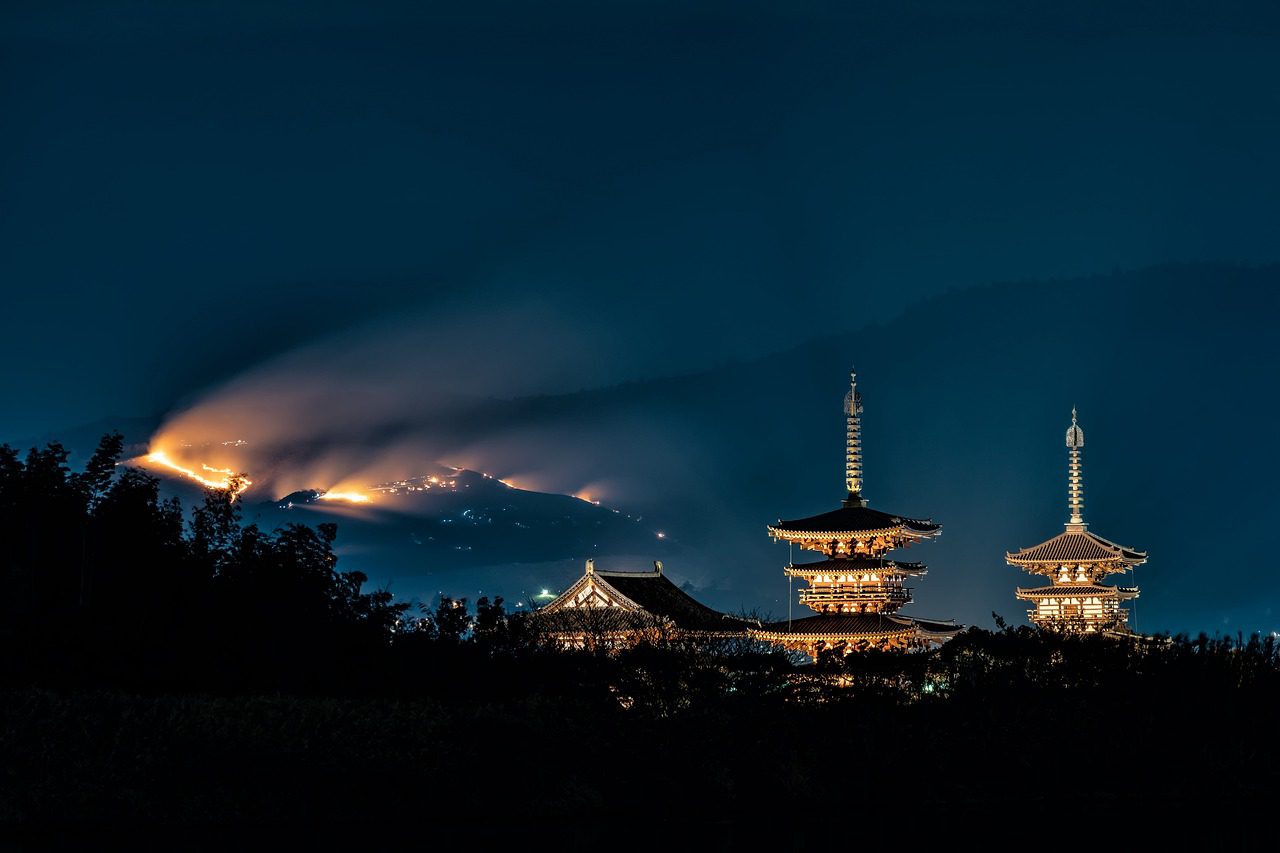Japan boasts a rich historical, cultural and spiritual legacy as well as aesthetically pleasing locations like calm, architecturally remarkable temples. From the ancient wooden construction of Nara to the polished gold of Kinkaku-ji in Kyoto, these Japanese temples offer evidence of the evolution of Japanese art, architecture, and religious practice over the years. Offering guests a haven from modern life and a great exhibition of Buddhist temples and Shinto shrines together with Japanese religious or spiritual traditions would help them to find serenity.
1. Todaiji Temple, Nara

UNESCO World Heritage site, Todaiji Temple is one of Japan’s most respected temples. The 752-year-old temple has the world’s largest wooden structure, the Daibutsuden, the Great Buddha Hall. One of the most famous Vairocana Buddha sculptures (15-story bronze) is on display. It is an important religious place and Kegon Buddhist knowledge center in Japan.
Address: 406-1 Zoshicho, Nara, 630-8211, Japan
Timings: Monday to Sunday: 8:00 am to 5:00 pm (depending on the season).
Events: A March Omizutori (Water-Drawing Ceremony) and an April celebration of Buddha’s Birthday.
How to Reach: Trains on the JR Nara Line to Nara Station and by bus or taxi to Todaiji Temple.
Features:
- Main hall (Daibutsuden) houses a 15m bronze Buddha statue.
- Lost, sprawling, historical timber structures, the finest in the world once at a time.
- UNESCO World Heritage Site status.
Suggested Read: https://korper-balance.today/check-visa-status/japan%3C/strong%3E%3C/a%3E%3C/p%3E
2. Senso-ji Temple, Tokyo

Senso-ji Temple, in Asakusa, is the most ancient Buddhist temple in Japan (in 7th century Japan). This temple is well known for its own very popular––sometimes even idiosyncratic––Kaminarimon (Thunder Gate), and blends tradition with modernity on the famous Nakamise Dori pedestrian shopping street. Inhabitants can snack, shop for memorabilia, and explore this bright religious location in Japan.
Address: 2 Chome-3-1 Asakusa, Taito City, Tokyo 111-0032, Japan
Timings: Monday to Sunday: 6:00 am to 5:00 pm (temple grounds available 24/7).
Events: May, Sanja Matsuri; July, Asakusa Hozuki-Ichi (Ground Cherry Market).
How to Reach: Take Tokyo Metro Ginza Line or Toei Asakusa Line to Asakusa Station, walk 5 minutes on foot.
Features:
- Iconic Kaminarimon Gate with a massive red lantern.
- Nakamise Shopping Street with snacks and souvenirs.
- Tokyo’s oldest Buddhist temple.
Suggested Read: How to Book Japan Visa Appointment
3. Horyu-ji Temple, Nara
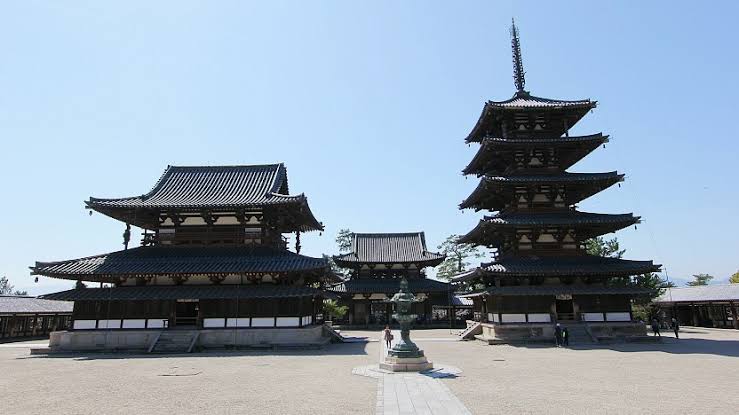
One of the places honoring the first timbered constructions in the world, the Horyu-ji Temple is located in Nara, Japan and is UNESCO World Heritage. Its large, five-story pagoda, exquisite specimen of early Buddhist architecture in Japan, and remarkable 607-aisle paper make it quite unique. History buffs and those visiting old Buddhist temples in Japan must make a stop here.
Address: 1-1 Horyuji Sannai, Ikaruga, Nara 636-0115, Japan
Timings: Monday to Sunday: 8:00 am to 5:00 pm.
Events: Seasonal cultural exhibits and Buddha’s Birthday festivities in spring.
How to Reach: Take a JR train to Horyu-ji Station and a 20-min, on foot or bus-ride to follow.
Features:
- World’s oldest wooden structures.
- Five-story pagoda and Kondo (main hall).
- UNESCO World Heritage Site designation.
4. Shitennoji Temple, Osaka

Given Osaka’s Shitennoji is among the oldest temples in Japan, it has great historical significance. Built by Prince Shotoku, this six-century structure features a five-story pagoda, the main hall, and a tranquil garden. This Japanese religious site reveals the spread of early Buddhism to that country. Wandering among its manicured grounds, visitors can appreciate its classic buildings and learn about an old Buddhist culture. Among Japanese temples, Shitennoji is a singular sightseeing location and a peaceful haven right in the middle of the metropolis.
Address: 1-11-18 Shitennoji, Tennoji Ward, Osaka 543-0051, Japan
Timings: Monday to Sunday: 8:30 am to 4:30 pm.
Events: Shoryoe (Prince Shotoku Memorial) in April and November.
How to Reach: Retrieve Osaka Metro Tanimachi Line and alight at Shitennoji-mae Yuhigaoka Station, and walk for 10 min.
Features:
- One of the oldest religious places in Japan.
- Five-story pagoda, treasure house, and Kondo.
- Peaceful garden with ponds and bridges.
5. Byodoin Temple, Uji

Among the most well-known temples in Japan, the Byodoin Temple at Uji is a UNESCO World Heritage Site. Built in the 11th century, the Phoenix Hall is a superb illustration of Heian period temple construction. This hall, shining with polished reflections on a calm pond, captures the Buddhist Pure Land ideal as written about. One of the most magnificent temples in Japan, Byodoin has artistic value combined with historical significance.
Address: 116 Uji Renge, Uji, Kyoto 611-0021, Japan
Timings: Monday to Sunday: 8:30 am to 5:30 pm.
Events: Uji Tea Festival in spring and summer illuminations.
How to Reach: Access by JR Nara Line to Uji Station, followed by a 10-minute walk.
Features:
- Besides special constructions such as Phoenix Hall, a National Treasure and UNESCO World Heritage Site.
- Stunning Heian period architecture.
- Surrounding pond reflects its intricate design.
6. Kinkaku-ji Temple, Kyoto

Chushingo-jō, known as the Golden Pavilion (or Kinkaku-ji), is considered one of the best temples in Japan. Located in Kyoto, its golden surface is bright on all sides surrounding a pond and produces an unforgettable image. This Buddhist temple in Japan is at the apex of Zen architecture and religious experience. With the temple as one of the top sites in Japan, thousands of visitors come every year.
Address: 1 Kinkakuji-cho, Kita Ward, Kyoto 603-8361, Japan
Timings: Monday to Sunday: 9:00 am to 5:00 pm.
Events: Seasonal light-ups during autumn and New Year celebrations.
How to Reach: By way of Kyoto City Bus 101 or 205 departing from Kyoto Station to Kinkaku-ji.
Features:
- Golden Pavilion covered in gold leaf.
- Beautiful reflection on the surrounding pond.
- Serene garden pathways and Zen landscaping.
7. Kiyomizu-dera Temple, Kyoto
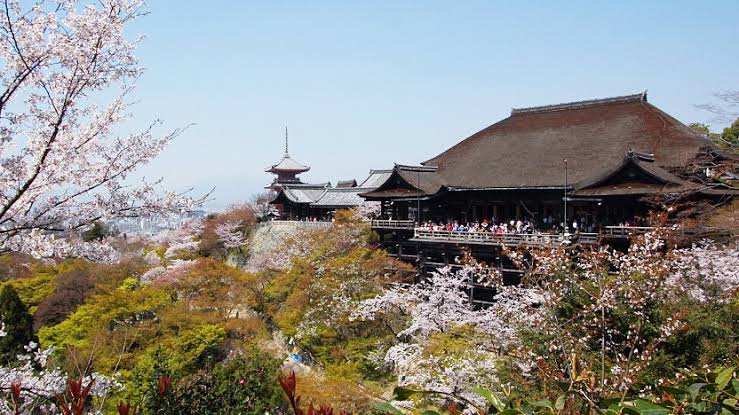
Kiyomizu-dera Temple is a historic religious place in Japan that is known for its precarious wooden platform that gives spectacular views over the city of Kyoto. Having been founded in 778, the name “Pure Water Temple” reflects the waterfall on its doorstep. This Buddhist temple in Japan is well known for its distinctive construction, which has been built from nothing but pins. Surrounded by cherry blossoms in spring and by colorful autumn foliage in autumn, Kiyomizu-dera is one of the most popular temples to visit in Japan.
Address: 1-294 Kiyomizu, Higashiyama Ward, Kyoto 605-0862, Japan
Timings: Monday to Sunday: 6:00 am to 6:00 pm.
Events: Spring and autumn night illuminations; New Year rituals.
How to Reach: Board a bus from Kyoto Station, transferring to Gojo-zaka or Kiyomizu-michi and then walking south for 10 minutes.
Features:
- Stunning wooden stage offering panoramic views of Kyoto.
- Seasonal beauty with cherry blossoms and autumn leaves.
- A waterfall with pure spring water flowing through.
8. Chion-in Temple, Kyoto
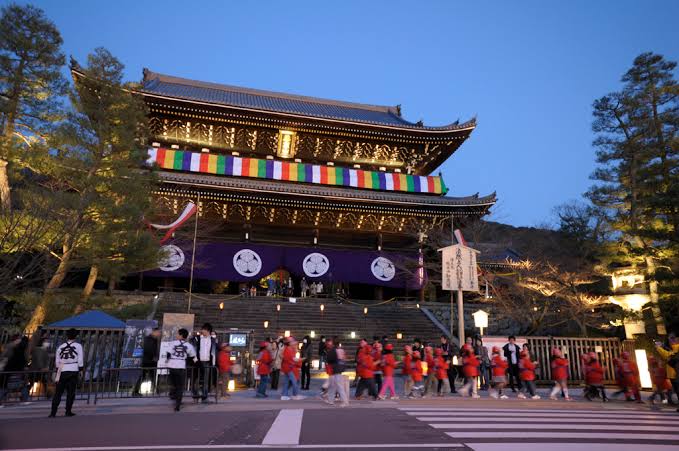
The temple–as the principal temple of the Jōdo-shū Buddhist school in Japan, is one of the most aesthetic religious places. With a massive temple gate in Japan as well as beautiful gardens and an impressive bell tower, it is located in Kyoto. Erected in 1234, the temple represents the monk Hōnen’s personal doctrine.
Address: 400 Rinka-cho, Higashiyama Ward, Kyoto 605-8686, Japan
Timings: Monday to Sunday: 9:00 am to 4:00 pm.
Events: New Year’s Eve bell-ringing ceremony; seasonal nembutsu chanting events.
How to Reach: Take the Kyoto City Bus to Chion-in-mae, then it is 5 minutes on foot.
Features:
- Grand Sanmon gate, one of Japan’s largest.
- Massive bell requiring 17 monks to ring.
- Headquarters of the Jodo sect of Buddhism.
9. Enryaku-ji Temple, Shiga
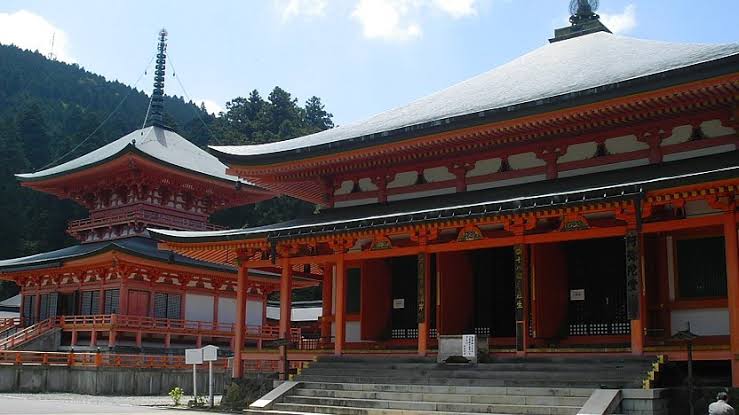
Enryaku-ji Temple, located on the mountain of Hiei, near Kyoto, is a UNESCO World Heritage site and one of the most prominent temples in Japan. Founded in 788 as the seat of the Tendai school of Buddhism. The temple complex is wide-ranging from sub-temples onwards and is breathtaking with mountain views. This temple, located in Japan, was a central one in Japanese Buddhism history, and also was a political power center.
Address: Sakamoto-honmachi, Otsu, Shiga 520-0116, Japan
Timings: Monday to Sunday: 8:30 am to 4:30 pm.
Events: Annual Saicho Festival in June; Buddhist prayer ceremonies.
How to Reach: A sightseeing bus from Kyoto Station to Sakamoto Cable Station then cable car hike up the summit of Mount Hiei.
Features:
- Headquarters of the Tendai sect of Buddhism.
- Expansive temple complex with multiple halls.
- Scenic mountain location with panoramic views.
10. Tenryu-ji Temple, Kyoto
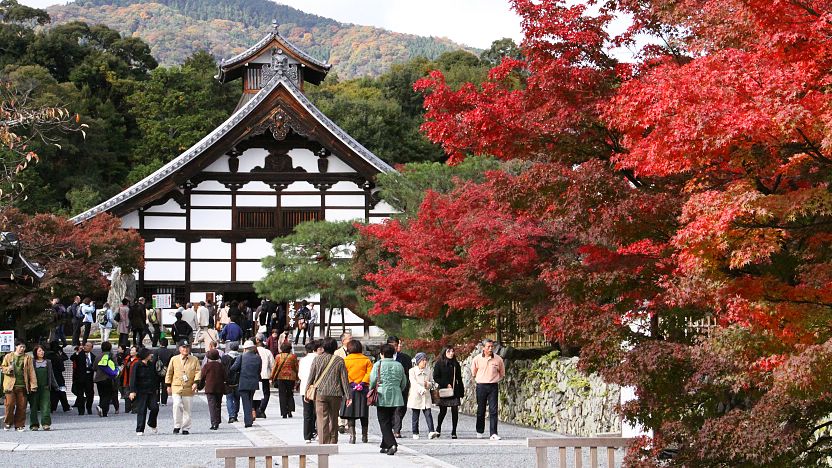
Tenryu-ji Temple is a Zen Buddhist temple in the Arashiyama district of Kyoto. Founded in 1339, it is well known for its beautifully designed landscape garden. The garden is all through its focal point, pond, and strategically placed rocks, an expression of classic Japanese architecture. Tenryu-ji, among the top temples in Japan, is a UNESCO World Heritage site as well.
Address: 68 Saga Tenryuji Susukinobaba-cho, Ukyo Ward, Kyoto 616-8385, Japan
Timings: Monday to Sunday: 8:30 am to 5:30 pm.
Events: Zen meditation workshops; seasonal flower festivals.
How to Reach: The JR Sagano Line to Saga-Arashiyama Station, and a 10-minute walk.
Features:
- Renowned Zen garden designed by Muso Soseki.
- UNESCO World Heritage Site.
- Located in Kyoto’s scenic Arashiyama district.
Suggested Read: https://korper-balance.today/check-visa-status/japan%3C/strong%3E%3C/a%3E%3C/p%3E
Why Choose OneVasco?
OneVasco makes visa applications effortless. Our expert team manages the entire process, allowing you to focus on your journey.
Enjoy stress-free travel with fast visa approvals.
- Expert and Personalized Support
- Efficient and Hassle-Free Process
- Real-Time Tracking and Updates
- Transparent Communication
- Trusted by Millions
FAQs
Can I join the temple rituals such as silent meditation or prayer gatherings?
Yes, meditation or prayer sessions are sometimes made possible for visitors in temples in Japan. For example, in temples such as Kiyomizu-dera and Enryaku-ji, it is possible to attend morning prayers, or guided meditation, however, it is advised to contact the temple directly to check whether these practices are available.
Do any temples in Japan offer Buddhist teachings or spiritual workshops for visitors?
Indeed, Buddhist temples, such as those in Japan (specifically Kyoto and Nara), provide spiritual workshops, lectures, or retreats. Temples such as Horyu-ji and Kinkaku-ji can and do arrange activities so that people visiting them can learn about Buddhist teachings and philosophy, and practices.
Are there many such temples (and shrines) in Japan that celebrate spectacular festivals or ceremonies?
Indeed! Numerous renowned temples in Japan, for instance, bank of the Jinmi river in Tokyo, including Senso-ji Temple. hold its own special festivals and ceremonies, e.g., the Setsubun Festival, a bean-throwing festival, at Senso-ji Temple, Tokyo or the Nara Lantern Festival at Todaiji Temple. These festivals offer the opportunity to witness the Japanese culture in its original shape.
How can I make offerings at Japanese temples, and what is the significance?
There are offerings, such as coins (for the most part, at the box of offerings), incense, or prayers to give, wherever you go. The making of an offering represents honor and an appeal for these blessings, health and safety. Before the ritual, make your offering, always observe temple customs, such as bowing, and clap.
Can I stay overnight at any temples in Japan?
Yes, overnight stay in Buddhist temples called shukubo is also available at temples such as those on Mount Koya. Visitors may take part in replicas of the monastic way of life, stay in rudimentary abbots’ rooms, attend early morning prayers, and have a customary vegetarian diet. It’s a unique cultural and spiritual experience.





